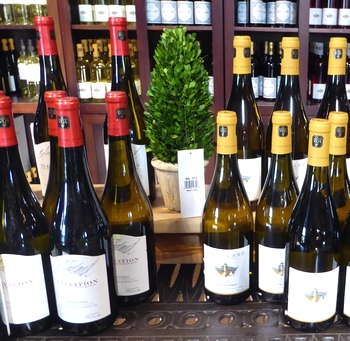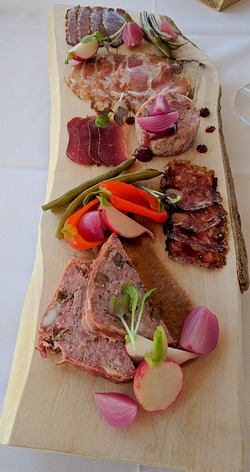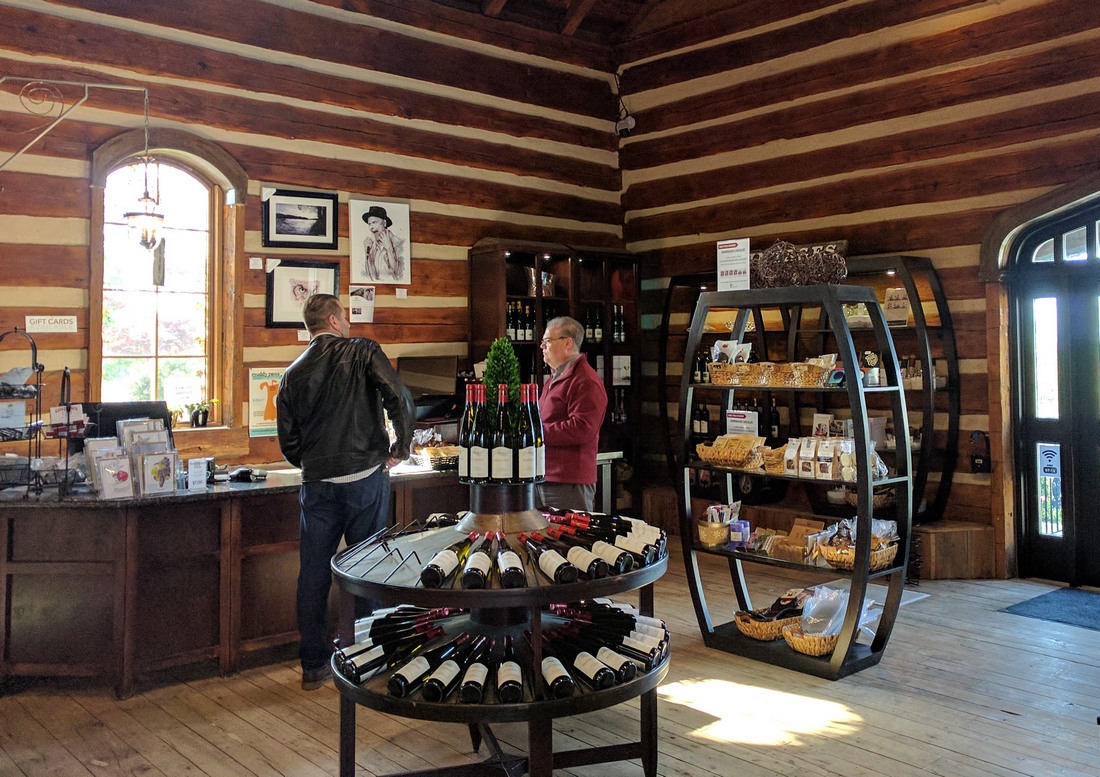“These trees are the beginnings of Canada,” David Hulley told us as he welcomed us to the cathedral-like log barn that serves as the tasting room of Vineland Estates Winery (vineland.com). “Trees were being cut down for warships. Some of them weren’t needed, so they were used for this barn.”
The 1877 structure and the landmark stone tower are among several practical and handsome buildings remaining from a 19th century Mennonite homestead. They perch on an elevated slope along the Twenty Mile Bench of the Niagara escarpment. The chinked log-cabin barn certainly makes the region’s most dramatic tasting room. The winery’s setting atop the rise among vineyards makes it among the most picturesque estates in the Niagara region.
The buildings anchor 42 acres of vineyards, including the initial 1979 plantings of the Weis 21 Riesling clone. Vineland founder Hermann Weis hails from Germany’s Mosel wine region and brought the clone that bears his family’s name to Canada. The winemaker and nurseryman was convinced that Riesling would thrive in this particular slice of the Niagara peninsula. The heat sink of Lake Ontario keeps the vineyards cool in summer and warm into the fall. The limestone soils have good drainage, and the slope between the Twenty Mile Bench and the lake encourages good air circulation. After tasting the wines in the rustic barn, we were convinced that Weis was on to something.
At the tasting bar
 The Elevation Riesling is Vineland’s signature wine. It is crafted with grapes from old vines in the St. Urban vineyard surrounding the winery. The 2015 ($20) is an outstanding example of the Mosel clone flourishing in the Niagara setting. The vines are in their fourth decade and produce grapes with impressive intensity, a citrus zing, and luscious fruit with overtones of ripe peach and apricot. Fermented fairly dry, it’s a very food-friendly wine. We also tried the 2008 ($30), which was made in a sweet German auslese style. The same stone fruits are present in the mouth, and the intense acids balance the residual sugars very well. It would be perfect with a game bird stuffing with chestnut dressing.
The Elevation Riesling is Vineland’s signature wine. It is crafted with grapes from old vines in the St. Urban vineyard surrounding the winery. The 2015 ($20) is an outstanding example of the Mosel clone flourishing in the Niagara setting. The vines are in their fourth decade and produce grapes with impressive intensity, a citrus zing, and luscious fruit with overtones of ripe peach and apricot. Fermented fairly dry, it’s a very food-friendly wine. We also tried the 2008 ($30), which was made in a sweet German auslese style. The same stone fruits are present in the mouth, and the intense acids balance the residual sugars very well. It would be perfect with a game bird stuffing with chestnut dressing.
And now the reds…
Riesling may have been the founder’s passion, but Vineland also found its niche red early on. “In Niagara, Cabernet Franc is king,” Hulley told us. “There are very few places in the world that can make pure Cabernet Franc.”
 Before trying a reserve Cab Franc, we sampled the 2014 Elevation Cabernet ($28). This elegant wine is a blend of two-thirds Cabernet Franc, one-third Cabernet Sauvignon. It was aged for 15 months in French oak with a light toast. The Cabernet Sauvignon contributes powerfully to the cedar and elderberry nose, but Cabernet Franc and its vegetative tannins dominate the mouth. It needs a few more years in the bottle—or a salty piece of meat—to show at its best. A fully mature 2009 Elevation Cabernet ($75) demonstrates a more harmonious marriage of the grapes. The tannins have softened and the fruit flavors have overtaken the vegetative flavors. The lush wine lingers on the palate like a sunset’s afterglow.
Before trying a reserve Cab Franc, we sampled the 2014 Elevation Cabernet ($28). This elegant wine is a blend of two-thirds Cabernet Franc, one-third Cabernet Sauvignon. It was aged for 15 months in French oak with a light toast. The Cabernet Sauvignon contributes powerfully to the cedar and elderberry nose, but Cabernet Franc and its vegetative tannins dominate the mouth. It needs a few more years in the bottle—or a salty piece of meat—to show at its best. A fully mature 2009 Elevation Cabernet ($75) demonstrates a more harmonious marriage of the grapes. The tannins have softened and the fruit flavors have overtaken the vegetative flavors. The lush wine lingers on the palate like a sunset’s afterglow.
Perhaps the best middle ground is the 2012 Vineland Estate Cabernet Franc Reserve ($50). It’s mostly (89%) Cabernet Franc with a mellowing touch of Merlot (9%) and just a hint of Cabernet Sauvignon. In a tasting, it shows leather and coffee on the nose and rich black fruits with bittersweet chocolate in the mouth. It makes you hungry for a steak.
At the table
Vineland also opened one of the first winery-based fine dining restaurants in the area. Simply called “The Restaurant,” it occupies an 1845 farmhouse (above) with expansive views across the vineyards. Executive chef Justin Downes grew up in the town of Vineland and studied at Niagara College. Like many Niagara chefs, he has a firm commitment to local products. After the teaser of the wine tasting, we were eager to pair some of the estate’s wines with Downes’ food.
 The flagship 2015 Vineland Riesling proved its versatility with our first two courses. The lemon-lime zestiness of the wine balanced nicely with a plate of briny Nova Scotia oysters on the half shell. With that wine, a mignonette was superfluous. Then Downes surprised us with a stunning platter that was almost a study in the branches of charcuterie. It included a marvelously mellow pâté de campagne with just a touch of brandy, an unctuous medallion of pork rillettes, thin slices of duck prosciutto, cured pork loin, and a chorizo with a healthy dose of black peppercorns. The pickled onions and green beans provided an acid counterpart. Once again, the Riesling more than held its own.
The flagship 2015 Vineland Riesling proved its versatility with our first two courses. The lemon-lime zestiness of the wine balanced nicely with a plate of briny Nova Scotia oysters on the half shell. With that wine, a mignonette was superfluous. Then Downes surprised us with a stunning platter that was almost a study in the branches of charcuterie. It included a marvelously mellow pâté de campagne with just a touch of brandy, an unctuous medallion of pork rillettes, thin slices of duck prosciutto, cured pork loin, and a chorizo with a healthy dose of black peppercorns. The pickled onions and green beans provided an acid counterpart. Once again, the Riesling more than held its own.
Every course was carefully thought out and meticulously executed. One pairing that surprised us was roasted quail with a kale pesto, wild spring mushrooms, a sunnyside-up quail egg, and a dab of ricotta. Downes served it with the 2014 Elevation Cabernet—the same wine we found too closed in the tasting. The salty little quail brought the wine alive. Because the meat had such a concentrated flavor from the browning, it stood up just fine to the wine. Below is the dish—beautiful and rustic at the same time.
Overviews
For an overview of Niagara wineries, see the web site of the Vintner’s Quality Alliance of Ontario (vqaontario.ca) or Visit Niagara (visitniagaracanada.com).



